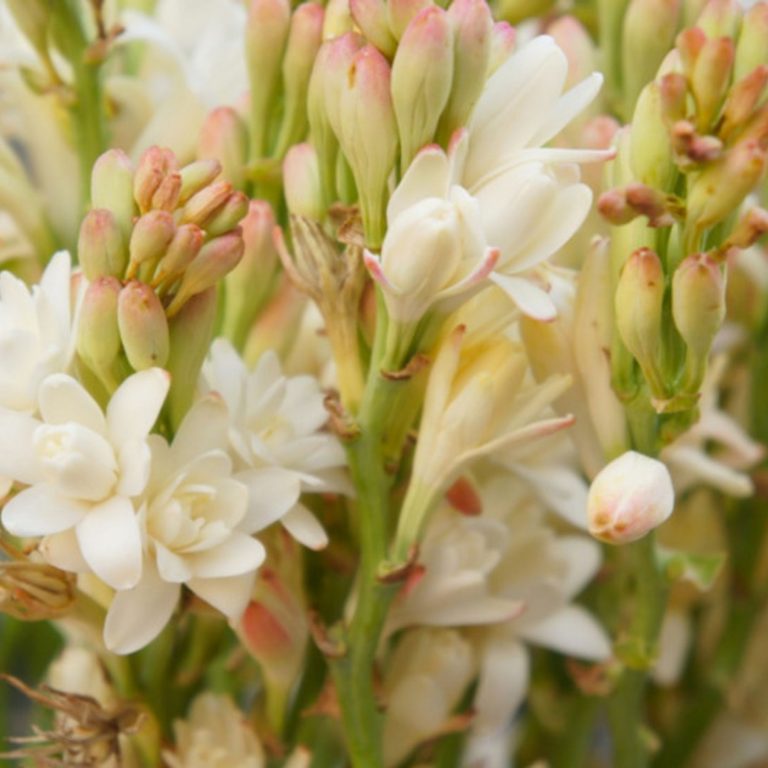Tuberose is also known as “Nishigandha” and “Sword Lily”. It is an evergreen herbaceous plant in which the flower stalk is 75-100 cm long. It is elongated, which produces 10-20 tamarind shaped white-coloured flowers. cultivate Rajnigandha Cut flowers are attractive, store for a long time and have a sweet aroma; hence they are used for making bouquets. Its open flowers are used to make garlands and Veni. Also, it is suitable for growing in beds and pots and is used for oil extraction.
Uses & Importance of Rajnigandha (Tuberose) Flower
This flower has many commercial uses in various areas. This flower has many services, increasing its demand and making it the best business option for farmers. Following are the benefits of Rajnigandha (Tuberose) Flower:-
- The flower is used to make artistic garlands, floral ornaments, gajras, buttonholes, essential oil extraction, and bouquets.
- Apart from arrangements, it is used for individual florets to provide fragrance to bouquets and boutonnieres.
- The tall flower spikes are excellent as cut flowers for table decorations. In addition, the blooms emit a pleasant aroma.
- The flower is used in aromatherapy to open the heart, calm the nerves, create peace and harmony, and restore joy.
- It has an extended use in perfumery as a source of aroma compounds and essential oils.
- This flower is used in cosmetic products and high-value perfumes.
- This Aromatic flower is also added to a favourite beverage prepared from chocolate with a stimulant or sedative and served cold or hot as desired.
- The bulbs of flowers have alkaloid -lycorine, which causes vomiting.
- The flower is also helped to make a paste by rubbing with turmeric and butter for the red pimples of infants.
- The powder form for dried tuberose bulbs helps as a remedy for gonorrhea.
Soil Requirement
Sandy and loamy are well-drained soils and suitable for Rajnigandha cultivation. For cultivation, it requires soil pH from 6.5 to 7.5. And you should also remember the requirement of irrigation twice a week.
Land Preparation
Rajnigandha cultivation requires the land to be well prepared. For making the soil crispy, 2-3 ploughings are necessary. At the planting time, it needs 10 – 12 tonnes of decomposed manure and then mixes everything well in the soil. Moreover, use powerful farming machines like tractor plough tools for plowing operations. It will help you with more precise seedbeds.
Seed Treatment
Its seed quantity is based on 2100-2500 bales used per acre. Before sowing, treat the bales with Thiram 0.3% or Captan 0.2% or Amisan 0.2% or Bentley 0.2% or Bavistin 0.2% @ 2 to protect against soil-borne diseases.
Sowing
The optimum time for sowing in Rajnigandha farming is from March-April. You can plant the seeds at a distance of 45cm. Also, prepare a nursery by making 90cm wide beds. In this way, you will get high benefits. Moreover, the sowing depth must be 5 to 7 cm deep in the ground. For getting better results, use the propagation method for Rajnigandha farming.
Please Visit sl618 net, For more interesting blogs.
Propagation
Farmers can do propagation with the help of bulbs having 1.5-2.0cm diameter and more than 30 gm weights. A clump of bulbs is sown per hill for propagation. For a year-old crop, 3 bulbs per hill and for more than one year crop period 1 or 2 bulbs per hill are planted. In doubles, only two should be produced for a year’s crop.
Fertiliser
At crop growth, apply Nitrogen @ 296 kg (Urea 640 kg) per acre. Apply half of the Nitrogen one month before sowing and the remaining dose of Nitrogen at an interval of one month till August. After applying fertilisers, irrigation is necessary.
Weed Control
To make the field weed-free, do 3-4 hand weeding. Immediately after sowing and 45 days after planting, apply Atrazine 0.6 kg/acre or Oxyfluorfen 0.2 kg/acre or Pendimethalin 800 ml. Spray the entire field before weeds grow by mixing 200 litres of water per acre. In addition, you can apply a tractor slasher for slashing the weeds.
Irrigation
Do not apply any irrigation till the knots germinate. Rinse once a week after germination and after 4-6 leaves appear. Depending on the soil and climate, 8-12 irrigations are necessary.
Flowers are harvested after 3-3.5 months of sowing. Its flowering time is in the month of August-September. It should be harvested when the 2-3 flowers will bloom. Cut the sticks with a sharp knife. An average yield of 1.4-2 lakh per acre can be earned in the first year from loose flowers and 2.5-4 lakh per acre from individual flowers.
In the second and next year, an average yield of 2-2.5 lakhs per acre can be earned from loose flowers and 4-5 lakhs per acre from individual flowers. After the flowers are plucked, the stalks are separated from the flowers, and the flowers are wrapped in sacks or cotton cloth and kept in the shade.
For more similar Blog details, stay with us.

